Презентація: 'Early Britain period'
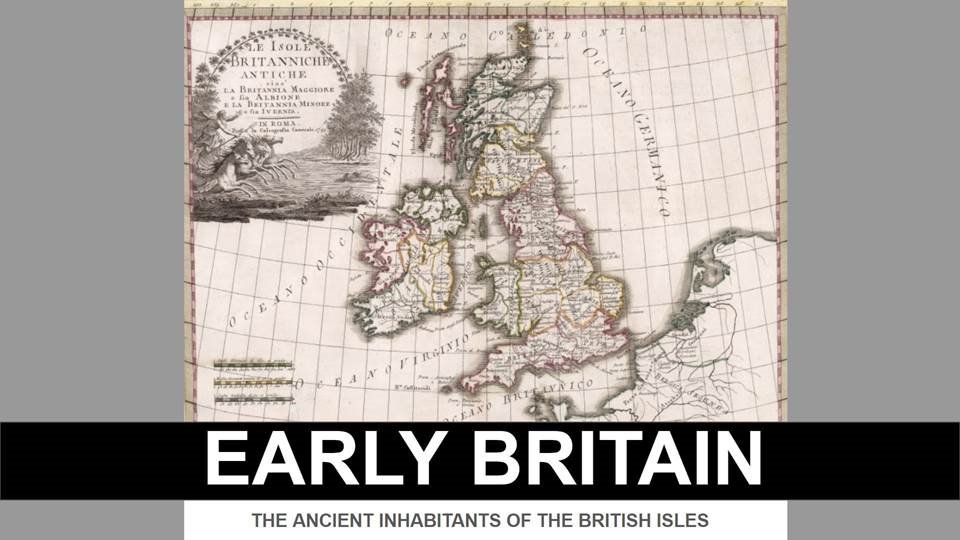
—STONEHENGE
CTOYHXeHA)K
0K. 2000 AO 14.9.
|
In some parts of Britain one can see a number of huge stones standing in a circle. These are the monuments left by the earliest inhabitants of the country. The best-known stone-circle, Stonehenge, dates from |
The whole monument is oriented towards the sunrise on the summer and winter solstices. It is supposed to be a sacred place where the early men worshipped the sun. Stonehenge is owned by the Crown and managed by |
between 2,000 and 1,600 B.C. It is made of many English Heritage. It is one of the most famous landmarks upright stones, standing in groups of twos, 8.5 metres in the United Kingdom, and it is regarded as a British high, each weighing about 7 tons. cultural icon.

Visual Reconstruction of Stonehenge
About three thousand years B.C. many parts of Europe, including the British Isles, were inhabited by a people known as the Iberians. All we know about them is that they used stone weapons and tools; the art of grinding and polishing stone was known to them, and they could make smooth objects of stone with sharp edges and points. It was they who built the beautiful Stonehenge.
In the 6th century B.C. some Celtic tribes invaded Britain. The Iberians were unable to fight back the attacks of the Celts who were armed with metal spears, swords, daggers and axes. Most of the Iberians were slain in the conflict; some of them were driven westwards into the mountains of what is now Wales. And the others probably mixed with the Celts.
THE CELTIC TRIBES
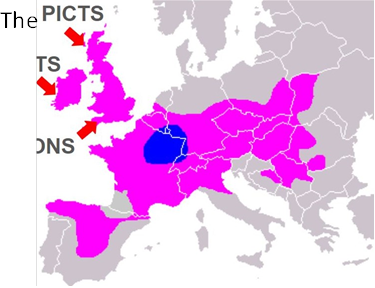 The SCOTS
The SCOTS
The BRITONS
During the period from the 6th to the 3rd century B.C. a people called the Celts spread across Europe from the east to the west.
THE CELTIC WARRIORS
THE CELTIC LEGENDS
of the Early Britain
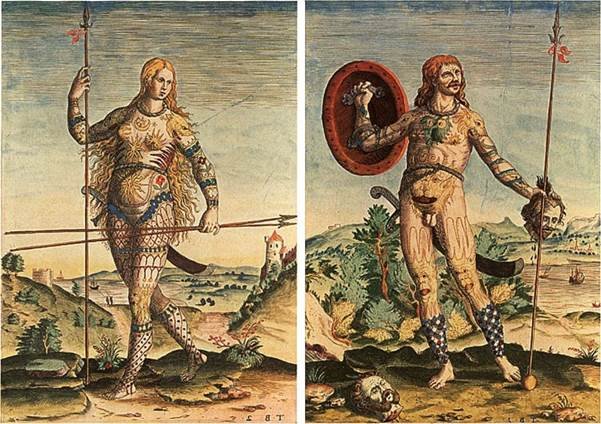 The old Celtic legends tell us about the woman warrior Scathach who taught young men all her warcraft. She lives on a far-away island in the east of Scotland. It was hard to reach Scathach's Island and to become her pupil.
The old Celtic legends tell us about the woman warrior Scathach who taught young men all her warcraft. She lives on a far-away island in the east of Scotland. It was hard to reach Scathach's Island and to become her pupil.
The famous hero of the Celtic legends, Cuchulainn, had to overcome many difficulties on his way to the island of the warrioress.
Here is how the end of the legend goes: "Cuchulainn went to Scathach, and put his sword to her breast, and threatened to kill her if she did not teach him all she knew. So he became her pupil, and she taught him all her warcraft. She also taught him how to use the terrible spear that no one else could use. No living man could overcome Cuchulainn since then."
The Celtic legends were translated into English and were called the "Celtic Sagas".
Part I. The Celts on the British Isles Questions for discussion:
1 . How did we get our information about primitive men?
2. What do we know about the Iberians?
3. Prove that the Celts were at the higher stage of social development than the Iberians.
4. How was the primitive society of a tribe governed?
5. What do we learn from the Celtic Sagas about Celtic arms and wars among tribes? Questions on the sagas:
6. What was the cause of the great war between Ulster and Connaught?
7. What conclusion does it allow us to draw about the main occupation and the main wealth of the
Celts?
8. What facts characterize Cuchulainn as a demigod?
9. What is the role of the druids and wise women?
10. What feats of Cuchulainn describe the Celts as travellers? What dangers did he face?
1 1 . How do the sagas show that the Celts were in a period of transition to class society?
ROMAN INVASION
The first Roman general to invade Britain was Julius Caesar. While fighting Celtic tribes in Gaul (modern France), he believed that they were getting help from the Celtic people of Britain. He resolved to invade Britain and punish those people.
In 55 B.C. a Roman army of 10,000 men crossed the Channel and invaded Britain. The Celts saw their ships approaching and rushed to attack the invaders in the sea as they were landing. The Celts made a great impressions on the Romans. Their hair and moustaches were dyed red and their legs and arms were painted blue. With loud shouts they attacked the Romans in chariots and on foot and the well-armed Romans had to return.
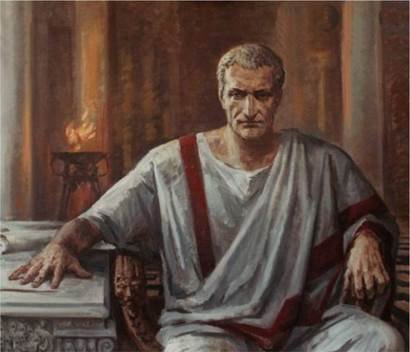
Julius Caesar, a Roman general, statesman and writer who lived since about 100 B.C. till 44 B.C..
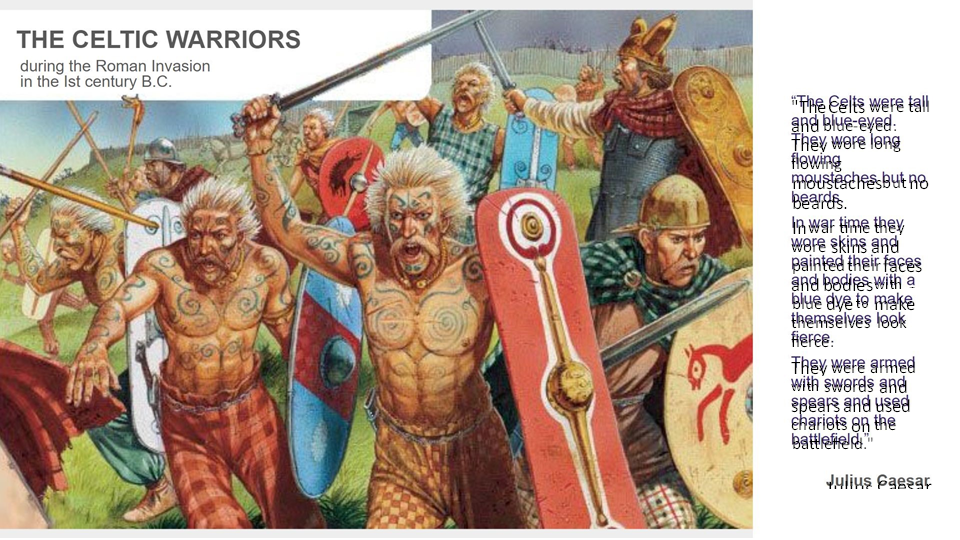

 |
In 54 B.C. a Roman army of 25,000 men under Julius Caesar again came to Britain. The Celts fought bravely for their independence but they were not strong enough, in spite of their courage, to drive the Romans off. The Roman army defeated the Celts in several battles. Since then
Britain was a province of the Roman Empire for about four centuries. As a result, the signs of Roman civilization spread over Britain.
KOHCTAHTM HOLIOJIL IV V
0T rpMH a K eoCTOKy OT O'
roe-on
H Ha•.ane V
K0HcmaHTMHa
P H o E M O P E
PKOMAHHU
5ABAPb')
o
Xep
co
O CTAÅTHHonOAb
nuua c 330 %)
o. Knop
o
B3HTwe B 455 r.
ROMAN BRITAIN
[l — V centuries]
In Britain there had been no towns before the Romans conquered it. The civilized Romans were city dwellers and road-makers. and as soon as they had conquered Britain, they began to build roads and towns, splendid villas, public baths and temples as in Rome itself.
The towns grew up as markets and centers of administration. Every town had a drainage system and a good supply of pure water. These towns were military stations surrounded by walls for defence which were guarded by the Roman warriors. A network of roads connected all parts of the country. Along the roads new towns and villages sprang up.
Early in the 5th century (407) the Roman legions were recalled from Britain to defend the central provinces of the Roman Empire from the attacks of the barbarian tribes. They did not return to Britain.
C E B E P H O E
o M O P E
Kai
|
B u exu ü c.Ru u |
MOC 0-aa 0. CapAHHMs' KapØaeeH |
AK3un PHM •,woJ'E @pØaeeH |
9 upoKy3b' 4 |
pecc o. KPM |
M |
|
|
Taxo B E c rpaHnua PHMCK0ü K KOHUY IV B. WIJIMR 06nacTH PMMCKO" |
C |
|||||
|
rpaH"ua paanena P"MCKO" MMnepnM B 395 r. 3anaAHaR P"MCKaq "Mnepy•lfi BocT0MHaq PMMCKaq "Mnepnq nneMeHa, HaceJIRBLLJHe EBpOny CAKCU repMaHcxne Mecra BpeMeHHb1X AHTb1 CnaBAHCKMe nneMéH A..r7AHb' apyrne nneueHa |
||||||
|
OCHOBHb1e HanpaBneHH9 91 BTopxeHHi nneMéH B b-1Mnepb-10 |
|
Pah0Hb1 BoccraHMÅ pa60a H KonoHOB |
|
|||
|
H0B • • • HAaIlOB — — — 6PMTTOB |
|
PH Mcwe norpaHL•1HHb1e yKpenneHMq |
|
|||
|
OCTr0TOB 6ypryHA0B apa60B |
X 378 3rpoM PEI MCKHX go"CK BecTroTaMn B cpaxeH'41.' npbl AApnaH0none |
|
||||
|
BecTr0TOB aHrnoB, caKCOB, |
X 451 nopaxeHV1e ryHHOB B 614TBe |
|
||||
|
|
||||||
ryHHb1
•paHKOB K)TOB KaHCXVIX nneMéH Ha KavanayHCKnx nongx
LéHépy
B 410 r. BaHAanaM'•1
pxeHne nocneAHero p"MCKoro MMnepaTopa.
3anaAHon PHMC Koi "Mneps-1H
Macwra6 1:19 000000
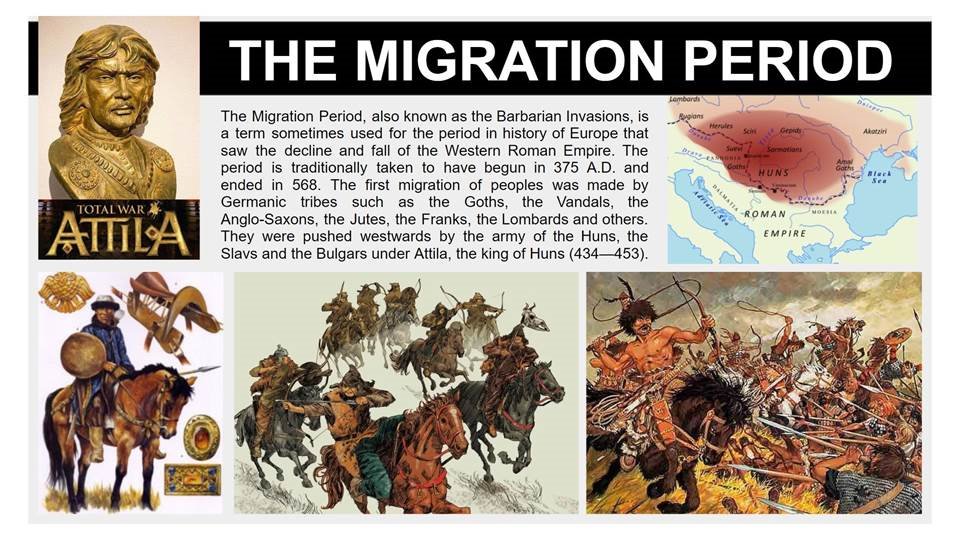
Part ll. The Celts Under the Romans Questions for discussion:
1 . How did the way of life in the Roman Empire differ from the life of the Celts in the 1st century A.D.?
2. What were the main differences between the slave-owning system and the primitive communal social system?
3. What did the Celts learn from the Romans?
4. How did the Roman way of life influence the life of the Celts?
5. Give reasons for the weak influence of the Romans over Britain.
6. What were the reasons for the weakening and fall of the Roman Empire?
7. What was the main cause for the migration period?
8. Who was the leader of multinational army that pushed the germanic tribes to the west to seek new places for settlement?
9. How long did the Huns' Empire exist?
1 0. How do we call the historical period between ancient times and modern times?
1 1 . How long did the Middle Ages last?


про публікацію авторської розробки
Додати розробку
